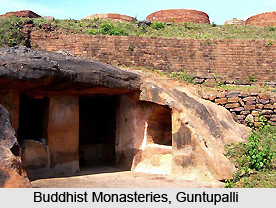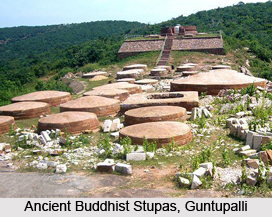 Guntupalli is an interesting Buddhist archaeological site which is present in the western part of Vijayawada in the Indian state of Andhra Pradesh. Some of the most marvellous instances of Buddhist relics and monolithic remnants dating back to the 2nd and the 3rd century BC continuing till the 5th to 6th century AD have been found here. Beautiful votive stupas, rock-cut temple or `Vritta Chaitya`, small monasteries, damaged `mandapa`, stone stupa, brick `chaitya` and a large monastery are the numerous archaeological relics have been unearthed from Guntupalli.
Guntupalli is an interesting Buddhist archaeological site which is present in the western part of Vijayawada in the Indian state of Andhra Pradesh. Some of the most marvellous instances of Buddhist relics and monolithic remnants dating back to the 2nd and the 3rd century BC continuing till the 5th to 6th century AD have been found here. Beautiful votive stupas, rock-cut temple or `Vritta Chaitya`, small monasteries, damaged `mandapa`, stone stupa, brick `chaitya` and a large monastery are the numerous archaeological relics have been unearthed from Guntupalli.
Rock-Cut Temple of Guntupalli
Also known as `Vritta Chaitya`, the rock-cut temple is circular in shape and is engraved on a rock-carved votive stupa and is surrounded by a circumambulatory pathway. `Dharmalingeswara` is the regional name of this rock-cut temple and it is equipped with a dome-shaped ceiling embedded with carved ribs along with decorative rafts which are similar to Bihar`s Lamasrishi and Sudama Caves.
Large Monastery of Guntupalli
This grand monastery is home to a large quantity of cells in which resided Buddhist monks. There exists a main entrance, with windows on its sides and a narrow `verandah` and also a terrace. Arched facades beautify the windows as well as the entrances of the monastery, just like the arches in rock-cut temple. The architecture of this monastery is quite simple and lacks the presence of elaborate ornamentation, and therefore it bears a resemblance to monastic architectural patterns of Buddhist monasteries. Deep cut channels have been created in the cells of the monastery to encourage the efficient draining of rainwater.
 Series of Stupas in Guntupalli
Series of Stupas in Guntupalli
Guntupalli comprises several stupas which are located over the terraces of the hills and amount to more than 60. These wonderful votive stupas have been built during various periods to mark different occasions, and their sizes differ depending on their style of construction and the time of their erection. Brick and stone have been utilized to construct all these votive stupas. Circular as well as tiny apsidal votive stupas are present.
Small Monastery of Guntupalli
This monastery is actually a rock-cut `vihara` which is located at higher altitudes of the hill and is smaller in size as compared to the other big monastery. It consists of five cells and its creation remains incomplete. However, its appearance has been adversely impacted due to the acts of destruction of Mother Nature.
Stone Stupa of Guntupalli
This stupa had been erected during the 2nd century BC and excavations have been carried out during the latter portion of the 19th century to unearth this famous stone stupa. However, prior to the excavations, extensive damage was inflicted on the stupa by some treasure seekers. The stupa`s dome measures about 2.62 in height and 4.88 metres in breadth, constructed over a circular base. Rock and gold crystals inside a stone casket have also been discovered from the site.
Ruined Mandapa of Guntupalli
Currently, tourists will come across just four broken stumps of the pillars of a building which was once a grand assembly hall. Inscriptions of the stone pillar which have been restored have revealed the presence of a pillared mandapa which had received some donations during the 1st to the 5th century AD. The original assembly hall measured 56 feet in height and 34 feet in width. Porches were existent on the western and eastern sides of the mandapa.
Brick Chaitya Griha of Guntupalli
The circular brick `chaitya griha` can be traced back to the 2nd century till the 3rd century and can be accessed by a series of stone steps. Records of an `upasika` claim that a collection of stone steps had been existent here which can be attributed to the 1st or the 2nd century BC. An impressive `adhistana` adorns the chaitya griha, whose diameter measured 11 metres. The Chaityagriha wall was 80 cms in height and 2.14 metres in width and there is a stupa at the central portion of the chaitya griha. A 1.38 metres wide circumambulatory pathway is present around the Stupa.




